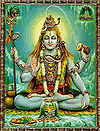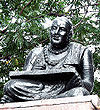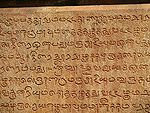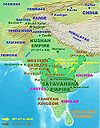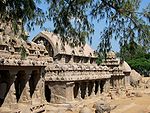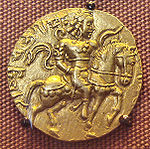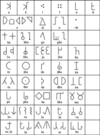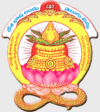Telugu The Language
| Telugu | ||
|---|---|---|
| Template:Lang | ||
| Spoken in | India | |
| Region | Andhra Pradesh | |
| Total speakers | 74 million native speakers as of 2001 | |
| Language family | Dravidian
| |
| Writing system | Telugu script | |
| Official status | ||
| Official language in | Template:IND | |
| Regulated by | not regulated | |
| Language codes | ||
| ISO 639-1 | te | |
| ISO 639-2 | tel | |
| ISO 639-3 | tel | |
| Linguasphere | ||
| Note: This page may contain IPA phonetic symbols in Unicode. | ||
by Sree Ganesh
Contents
Etymology
The most popular explanation for the etymology of the word telugu (తేలుగు) is that it comes from the word Trilinga which literally means: belongs to the land of three Siva (Hindu god) Temples and therefore refers to the three temples at Srisailam, Drakasharamam, and Kaleshwaram. However, not many scholars accept this view.[1]Let us examine some of the other views here.
Khandavalli Lakshmi Ranjanam (1962) [2] assumes that the word Telugu comes from the word Talaing . Since tala in Telugu refers to head, Talaings refers to leaders. Probably, Talaings were a civilization that conquered the people living in the area of current Andhrapradesh. Hence they had the name Talaings. Later this must have given rise to the words Telungu and Trilinga .
Godavarti Ramadasu (1980) [3] claims that the word Telugu comes from the Sanskrit forms Trilinga or Trikalinga. The word kalinga itself is a Dravidian word. In the Kui language, rice is called kulinga. Since the Kuis were mainly rice eaters, Aryans might have called them Kulingas or Kalingas.
According to Marepalli Ramachandra Shastri (1976) [4], in the Gondi language, unga is the plural form. telu which means white. Hence, Telunga might refer to people who are white in complexion.
Ganti Jogi Somayaji (1947) [5]asserts that ten refers to the South in Proto-Dravidian. Hence Tenungu refers to Southerners.The etymological relationship between Telugu and Tenugu is still an open question. P.S Subramanyam say that Tenugu is older than Telugu because Nannaya used the word Tenugu and Ketana who is younger than Nannaya used the word Telugu in his book titled Andhra Bhaashaa Bhushanam. In his book, The Dravidian languages [6] mentioned that the word Telugu has been derived from Tenugu (TenuMgu).
The most popular notion is that the first person to use the word Trilinga was Vidyanaatha in Bruhatkatha Kakatiya dynasty (from 1083 CE to 1323 CE). Actually, the first person to use the word Trikalinga was Rajashekhara in his inscription Vidhdhasaala Bhanjika. He also was the first person to use Trikalinga with a ra vattu (త్రి-త్+ర+ఇ) (with gemination) Khandavalli Lakshmi Ranjanam (1962) [2].
Markandeya and Vayu puranas mention only Tilinga. One of the oldest works in Tamil called Agattiyam says Konganam Kannadam Kollam telungam which means Kongam, Kannadam, Kollam, Telugu are Dravidian languages.
Epigraphy
The first inscription that is entirely in Telugu dates back to 575 AD and was found in the Rayalaseema region. It is attributed to the Renati [Renati Cholas Cholas], who broke with the prevailing custom of using Sanskrit and began writing royal proclamations in the local language. During the next fifty years, Telugu inscriptions appeared in Anantapuram and other neighboring regions. Telugu was more influenced by Sanskrit than by Prakrit during this period, which corresponded to the advent of the Telugu literature. This literature was initially found in inscriptions and poetry in the courts of the rulers, and later in written works such as Nannayya's Mahabharatam (1022 AD). During this time which was also a period of phonetic changes in the spoken language of Nannayya, the literary language started to diverged from the popular language.The third phase in the development of the written language is marked by further stylization and sophistication. Ketana (13th century) prohibited the use of spoken words in poetic works. During this period the separation of the Telugu script from the common Telugu-Kannada script took place. Tikkana wrote his works in spoken language.
The period of the late 19th and the early 20th centuries saw the influence of English and modern communication/printing press as an effect of the British rule, especially in the areas that were part of the Madras Presidency. Literature from this time were a mix of classical and modern traditions and included works by scholars like Kandukuri Viresalingam and Lakshminarasimha Rao who did recognizable work for Modern Telugu.
Since the 1930s, what was considered an elite literary form of the Telugu language has spread to the common people due to the mass media.
Historical Background
The earliest traces of Telugu are found in Prakrit context in inscriptions of the final centuries BC. Telugu was strongly influenced by Prakrit/Sanskrit from prehistoric times and by Urdu and Hindi in modern times.[3] Epigrapher evidence suggests that during the Satavahana dynasty, the rulers spoke Prakrit while the general population spoke an early form of Telugu.Inscriptions containing Telugu words dated to 400 BC were discovered in Bhattiprolu in Guntur district. The English translation of one inscription reads: "Gift of the slab by venerable Midikilayakha (name of a king)". Telugu words appear in the Maharashtri Prakrit anthology of poems - the Gatha Saptashati collected by the 1st century BC Satavahana King Haala. Andhra was originally the name of a tribe. Gradually the area where this tribe settled was called "Andhra". There is a valley near Bombay called the "Andhra Valley". There is a small river in Maharashtra called "Andri". A sub-river of Tungabhadra is also called "Handri" (handri). During 220 AD the word "Andhrapathamu" (Andhra region) was used in the inscriptions in Ballari district. This is the evolutionary sequence of the word "Andhra". The language spoken by Andhras was given the name "Andhra Bhasha" (Andhra language).[2]
Different tribes used to speak different languages in Andhrapradesh. The tribes of Andhra such as Dravida, Yaksha, and Naga spoke "Telugu" or "Tenugu". Andhras from North India used to speak another language called "Desi". Telugu belongs to the family of Dravidian languages together with Tamil Kannada, and Tulu.[6]
TELUGU TAMIL KANNADA ENGLISH
------------------------------------------------------------------------
tala talai tale head
nela nila nila earth
puli puli puli, huli tiger
Uru Ur Ur village
magavaaDu magas magan male
uppu uppu uppu salt
pappu parupu papu dall
paTTi paRRu paDe wood
ekku ERu ERu grind
------------------------------------------------------------------------
You might have observed the phonetic similarities among these languages. Detailed information is available here: Typological_Features_Template_for_Telugu
Satavahana kings official language was "Prakrut". Prakrut was also the language used by kings those days - Royal Language. For the first time Telugu words can be observed in the Ikshavaku inscriptions after Satavahana's rule. The Nagarjuna Hill inscriptions of 250 AD contain Telugu words like "naagamna", "viiramna", and "mahaa talavara". "talavara" is a Telugu word in "mahaatalavara". "talaari" or "talavara" means head of the village or town. In Tamil, "talaivaar" means big boss. This Telugu word was combined with a Sanskrit word "maha'". Telugu language spoken by people contains some original words and some sanskritized words. People those days used to speak Telugu and rulers spoke Prakrut. The following is from the inscriptions of Pallava King, Sivaskandavarma (in prakrut):
kaanciipuratO yuvamaha raajO Baaradaayasa gotto palavaanam navaKandavammO dharmaKDe vaaptam aanapayati. andhapatiiyagaamO..... viriparam amhEhi Udakaadim sampadato Etasa gaamana virivarasa nava bamhadEya parihaalO vitarama.The meaning of the above inscription: The Viripara (now Epparru) village of Andhra is being donated by Sivaskandavarma (Pallava king).
The inscription of Chalkya Jayasimha Vallabha (in Telugu) is the following:
jayasimhavallaBa maha'raaju la'kun pravardhamaana vijayaraajya samvatsarambuLa - eNumbOdi anmENNa ammin pooNNamanaaNNum mlaavinDi raajula muTlu kalimuDiraajul mlaavinDi samudrarakai naaku baNisEsina kalci viiRuruRla maddi kadu mooTiki vitaRti Uttarambuna pulOmbuna CeRuvu paDumaaRi kOTan eRRumBOdi puTlu aRla paTTu sEnutaaRii tOmTa laayu paDuvaarambu icciri.
The above two inscriptions depict the differences between Telugu and Prakrit languages.
The ancient inscriptions contain the names of villages ending in a word "Uru" e.g. "kooDooru", "ELooru". The word "Uru" is close to the word "Ur" in the Southern languages. These village names confirm the relationship of the Telugu with the Dravidian languages.
Telugu language spoken by the Dravidians, Yakshas, and the Nagas was influenced by Desi, Sanskrit, and Prakrut. Sanskrit and Prakrut belong to the same group. Literary language is Sanskrit and spoken one is Prakrit. There is no difference in basic vocabulary or style of sentence construction among Desi, Sanskrit and Prakrit. The preachers of Buddhism wrote their books in Prakrit for easy understanding. The language of Andhra was not Prakrit. While writing Bruhatkadha, Gunadya (350 AD) said the following:
samskruta, praakruta, dESi Baasha lanu parityajimci nEnu paiSaci BaashalO bruhatkadhanu vraastunnaanu. (I left Sanskrit, Prakrit and Desi languages and I am writing this Bruhatkadha in Paisaci language)
Till today, languages called Braahuyi in Balochistan has Telugu words like "kaaDu" "maarTu", "Oreyaan". These languages belong to family of Dravidian languages. Dravidian inhabited North India prior to Aryan aggression. On the banks of river Sindhu, Aryans created the Harappa and Mahenjadaro cultures. Even though Dravidian came and settled in South India, their relatives (some tribes) still remained in the North India. Their languages belong to the family of Dravidian languages. "Papai" in Afganisthan, "shiina" in Kashmiri, and "Brahuyi" in Balochistan share similarities with Dravidian languages.[6] All these languages are classified in "Dardik Class" of languages.
"Desi" of Andhras belongs to this class of languages (Dardik). Before settlement in South India, Andhras lived in the Vindhya for some time. Hill tribes of Vindhyas still speak Dravidian languages like "kaanDu", "maarTu", and "oriyaan". Before arriving at the banks of Ganges and Jamuna, Andhras might have visited Beloochisthan, Afganisthan, and Kashmir. This is what historians propose.
Paisachi is an offshoot of Desi. Desi was the ancient language of Kashmiris and Nepalis.
Linguistics experts showed that. [6]The history of Telugu language offers a nice example for the above statement. For about 500-600 years during the Satavahana's rule, Prakrit was used as the royal language in Andhra. Tadbhavas from Prakrit infiltrated the Telugu language. But Telugu did not die. Telugu incorporated the required words from Prakrit and discarded the rest. Guptas of North India and Pallavas of South India fought battles in 400-500 AD. These battles killed the royal language, Prakrut. Finally, Prakrut rested in the Buddhism books in Tibet. Following, Sanskrit influenced Telugu of Andhras for about 500 years. During 1000-1100 AD, Nannaya's Telugu in Mahabharata, Telugu in several inscriptions, Telugu in poetry reestablished its roots and dominated over the royal language, Sanskrit. Telugu absorbed the Tatsamas" from Sanskrit only. (Tatsama is a kind of classical dialect which was equal to Sanskrit and Prakrit. Nannayya has followed this Tatsama variation in his Mahabharata).[3]
It sows that languages belonging to the same class can combine into one and languages belonging to different classes even though can survive in harmony, the strongest language survives and the weaker one dies. Languages belonging to two different classes can not combine.
Development of Telugu from Proto-Dravidian
According to the Russian linguist M.S. Andronov, Proto-Dravidian gave rise to 21 Dravidian Languages. [6] They can be broadly classified into three groups: Northern group, Central group, and Southern group of Dravidian languages.Kannada split from Proto-Dravidian around 0 BC. Note that the current similarity in scripts between Kannada and Telugu has a lot more with Chalukyas rule of Andhra than the similarity between the languages. Admittedly, Kannada is Telugu's closest cousin. In India the history of scripts has been almost independent of the history of languages [6].
Proto-Dravidian gave rise to totally 21 Dravidian languages [6]. They are:
i. Northern Group
1. Brahui
2. Malto
3. Kudukh
ii. Central Group
1. Gondi
2. Konda
3. Kui
4. Manda
5. Parji
6. Gadaba
7. Kolami
8. Pengo
9. Naiki
10. Kuvi
11. Telugu
iii. Southern Group
1. Tulu
2. Kannada
3. Kodagu
4. Toda
5. Kota
6. Malayalam
7. Tamil
The other languages in the Central group provide invaluable information in deducing the pre-history of Telugu. Gonds and Koyas (speaking Konda language) are closely related tribes. Gonds have an interesting story about the origin of their tribe. It also matches the story Koyas have to say about their origin.
Dialects
Waddar,Chenchu,Savara, and Manna-Dora are all closely related to Telugu. Dialects of Telugu are Berad, Dasari, Dommara, Golari, Kamathi, Komtao, Konda-Reddi, Salewari, Telangana, Warangal, Mahaboob Nagar (Palamuru), Gadwal (Rayalaseema mix), Narayana peta (Kannada and Marathi influence), Vijayawada, Vadaga, Srikakula, Visakhapatnam, Toorpu (East) Godavari, Paschima (West) Godavari, Kandula, Rayalaseema, Nellooru, Prakasam, Guntooru, Tirupati, Vadari and Yanadi (Yenadi).[7]
In Tamil Nadu the Telugu dialect is classified into Salem, Coimbatore, and Chennai Telugu dialects. It is also widely spoken in Virudhunagar, Tuticorin, Madurai and Thanjavur districts. Along with the most standard forms of Indian languages like Tamil, Kannada, Hindi, Bangla, Gujarati, Oriya and Marathi, Standard Telugu is often called a Shuddha Bhaasha ("pure language").
Orthography
Telugu is written in Telugu script which is derived from Ashokan Brahmi used in the South India cerca 2nd A.D. By the end of 13th Century A.D, the Telugu and Kannada scripts got separated[8]. In the early combined Telugu-Kannada script, no orthographic distinction was made between the short mid [e, o] /Fs, I/ and long mid [] /G, J/. However, distinct signs were employed to denote the special consonants viz. the trill [] /àá/ the retroflex lateral [] /ÎÏÁ/ and the retroflex palatal [Z a] found only in South Indian languages, by 5th c.Reference
- ↑ 1.0 1.1 Pratapareddy.S, (1997) Andhrula samghika charitra, Orient Blackswan Pvt Ltd.
- ↑ 2.0 2.1 2.2 Lakshmi Ranjanam.K, (1962) Andhrula charitra, Telugu academy.
- ↑ 3.0 3.1 3.2 Ramadasu.G, (1980) Telugu bhasha charitra, Telugu academy.
- ↑ Ramachandra Sastry.M, (1980) Dravida bhashalu, Andhra viswa kalaparishat.
- ↑ Somayaji.G.J, (1947) Andhra Bhasha Vikasam, Andhra viswa kalaparishat.
- ↑ 6.0 6.1 6.2 6.3 6.4 6.5 6.6 Krishnamurti.BH, (2003) The Dravidian languages. Cambridge, Cambridge university press.
- ↑ Krishnamurti.BH, (2004) Bhasha samajam samskruthi, emesco publications.
- ↑ Korada Mahadeva sastry, (1986) Historical grammar of Telugu, emesco publications.
===ధన్యవాదాలు===
Thanks
